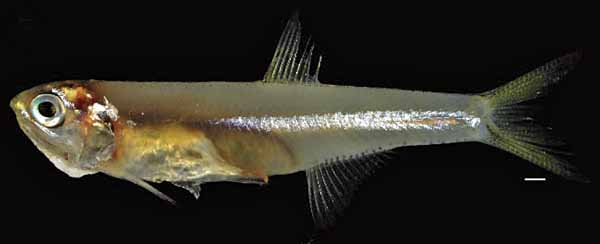Stolephorus eldorado
Hata et al., 2022
|
Familie: Engraulidae Lokale Bezeichnung |
 Stolephorus eldorado (KAUM I. 110282, 49.5 mm SL, Ke-tzu-liao, südwestliches Taiwan; Maßstab = 2 mm) -- (C) Hata et al., 2022 in: ZooKeys, 1121: 145-173. |
Typen
Holotypus: KAUM I. 94517 .
Siehe: Eschmeyer, W.N., Fricke, R. & Van der Laan, R. (eds.) 2024. Catalog of Fishes electronic version
Typusfundort: Ha Long Bay, Ha Long Stadt, Quang Ninh Distrikt, Vietnam (gekauft auf dem Fischmarkt in Ha Long City).
Etymologie
El Dorado bezieht sich auf die mythische Stadt aus Gold, und spiegelt die leuchtend gelbe Färbung der Art wider.
Verbreitung
Pazifik: westlicher Pazifik von Taiwan bis Java, Indonesien. Die Art wird reichlich mit Schleppnetzen gefangen und in Nordvietnam frisch vermarktet. Im Südwesten Taiwans ist sie ein Beifang in Stellnetzen.
IUCN Status

EX Extinct (ausgestorben)
EW Extinct in the Wild (in der Natur ausgestorben)
CR Critically Endangered (vom Aussterben bedroht)EN Endangered (stark gefährdet)
VU Vulnerable (gefährdet)
NT Near Threatened (potenziell gefährdet)
LC Least Concern (nicht gefährdet)
RE Regionally Extinct (regional oder national ausgestorben)DD Data Deficient (ungenügende Datengrundlage)
NE Not Evaluated (nicht beurteilt)
Status: Stand 5.10.2022: NE Not Evaluated (nicht beurteilt)
Gefahren für diese Art: (nicht beurteilt)
Literatur
- Whitehead, P.J.P., Nelson, G.J. & Wongratana, T. 1988. FAO species catalogue vol 7. Clupeoid fishes of the world (suborder Clupeoidei). An annotated and illustrated catalogue of the herrings, sardines, pilchards, sprats, shads, anchovies and wolf-herrings. Pt 2 – Engraulidae. FAO Fisheries Synopsis, no 125. FAO, Rome, i–viii + 305–579. Zitatseite [:413, z.T.: unnum. Abb. (Taiwan bis Java Sea), als Stolephorus insularis]
- Young, S.-S., Chiu, T.-S. & Shen, S.-C. 1994. A revision of the family Engraulidae (Pisces) from Taiwan. Zoological Studies, 33 (3): 217–227.(PDF) Zitatseite [:222, fig. 7 (Westküste Taiwans), als Stolephorus insularis]
- Wongratana, T., Munroe, T.A. & Nizinski, M.S. 1999. Order Clupeiformes. Engraulidae. Anchovies. In: Carpenter, K.E. & Niem, V.H. (eds): FAO species identification guide for fishery purposes. The living marine resources of the western central Pacific, vol 3. Batoid fishes, chimaeras and bony fishes pt 1 (Elopidae to Linophrynidae). FAO, Rome, pp 1698–1753. Zitatseite [:1736, z.T.: unnum. Abb. (Taiwan bis Javasee), als Stolephorus insularis]
- Zhang, S.-Y. 2001. Fauna Sinica. Osteichthyes. Acipenseriformes, Elopiformes, Clupeiformes, Gonorhynchiformes. 2001: i-vii + 1-209. Zitatseite [:129, fig. II-59 (Beihai City, Provinz Guangxi, China), als Stolephorus tri]
- Hata, H., Lavoué, S. & Motomura, H. 2019. Taxonomic status of seven nominal species of the anchovy genus Stolephorus described by Delsman (1931), Hardenberg (1933), and Dutt and Babu Rao (1959), with redescriptions of Stolephorus tri (Bleeker 1852) and Stolephorus waitei Jordan and Seale 1926 (Clupeiformes: Engraulidae). Ichthyological Research, 67: 7–38. (doi) Zitatseite [:24, z.T.: fig. 12a, b, (Taiwan; Hainan Island, China; Ha Long Bay, Vietnam; Gulf of Thailand; Songkhla, Thailand; Kuala Terengganu, Terengganu, Malaysia), als Stolephorus bengalensis]
- Hata, H. 2018. Stolephorus insularis Hardenberg, 1933. P. 41 in
- Kimura, S., Imamura, H., Nguyen, V.Q. & Pham, T.D. (Eds.) 2018. Fishes of Ha Long Bay, the natural world heritage site of northern Vietnam. Fisheries Research Laboratory, Mie University, Shima, ix + 314 pp. (PDF) Zitatseite Zitatseite [: 41, unnum, Abb. (Ha Long Bay, Nordvietnam), als Stolephorus insularis]
- Hata, H. 2019. Family Engraulidae. Pp. 199–210 in:
- Koeda, K. & Ho, H.-C. (eds) 2019. Fishes of southern Taiwan. National Museum of Marine Biology & Aquarium, Pingtung. Zitatseite Zitatseite [:206, unnum. Abb. (Ke-tzu-liao, Ziguan District, Kaohsiung, Taiwan), als Stolephorus bengalensis]
- Hata, H., Koeda, K., Aizawa, M., Sakamoto, K. & Ueshima, R. 2022. A list of Clupeiformes (Actinopterygii: Teleostei) specimens deposited in the Department of Zoology, The University Museum, The University of Tokyo. The University Museum, The University of Tokyo. Bulletin, 128: 17–58. Zitatseite [:34, z.T.: Wenzhou City, Zheijiang Province, China, als Stolephorus bengalensis]
- Hata, H., Lavoué, S. & Motomura, H. 2022. Description of three new species previously identified as Stolephorus bengalensis (Dutt & Babu Rao, 1959) or Stolephorus insularis Hardenberg, 1933 and a re-description of S. bengalensis (Chordata, Osteichthyes, Clupeiformes, Engraulidae). ZooKeys, 1121: 145-173. (doi) Zitatseite [:165, Figs 1A, B, D, E, F, 11, !!]